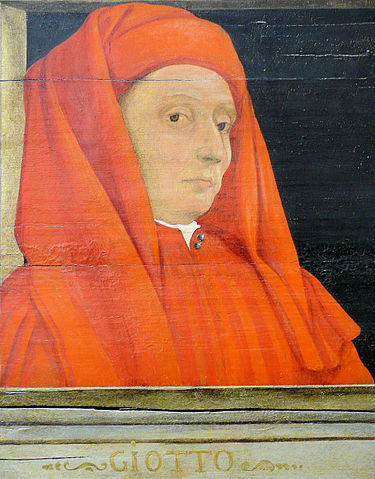
Born: c. 1267, Florence
Died: 8 January 1337, (aged 69-70)
Period: Late-Gothic
The Life of Giotto di Bondone
Giotto di Bondone, often known simply as Giotto, is heralded as one of the most significant artists in the transition from the medieval period to the Renaissance in European art. Born near Florence, Italy, Giotto broke away from the Byzantine style prevalent in his time, introducing more realistic representations of space, volume, and human emotion. His innovations laid the groundwork for the development of Renaissance art, influencing countless artists who followed.
There are many legends about Giotto’s early life, including the famous story told by Giorgio Vasari about Giotto drawing a perfect circle freehand to demonstrate his skill to the Pope. What is certain is that Giotto was recognized in his lifetime for his exceptional talent. He was apprenticed to the Florentine painter Cimabue, another key figure in the movement away from the Byzantine style, but Giotto’s work would soon surpass the master’s in fame and influence.
Giotto’s contributions to art are not limited to his advances in realism. He also had a profound impact on the use of perspective, creating depth in his paintings in a way that had not been seen before. His frescoes, characterized by their clarity, simplicity, and expressive power, can be found in several Italian cities, most notably in the Scrovegni Chapel in Padua, the Basilica of Saint Francis in Assisi, and the Florence Cathedral.
The Scrovegni Chapel frescoes, completed around 1305, are perhaps his most famous work, depicting the life of the Virgin Mary and Christ in a cycle that combines emotional depth with detailed narrative. These paintings mark a significant departure from the static and symbolic figures of Byzantine art, portraying instead scenes filled with drama and humanity.
Throughout his career, Giotto was highly sought after and received commissions from some of the most influential figures of his time, including the Papacy. Despite the high demand for his work, very few pieces can be attributed to Giotto with certainty due to the lack of signed works and the prevalence of his followers’ paintings, which were often mistaken for his.
Giotto’s legacy is immense, as he is often cited as one of the first artists to contribute to the Renaissance’s ideals and methods, laying the foundations for future giants like Michelangelo and Leonardo da Vinci. His emphasis on naturalism, observed through his innovative approach to depicting the human figure and space, marks him as a pivotal figure in the history of Western art.
Giotto di Bondone’s Notable Works
Giotto di Bondone, renowned for his pivotal role in art’s evolution towards the Renaissance, left behind a legacy of works celebrated for their revolutionary approach to realism, emotion, and human-centric narratives. Here are ten of Giotto’s most famous and influential works, which underscore his mastery and profound impact on the trajectory of Western art:
- Scrovegni (Arena) Chapel Frescoes (c. 1305) – Located in Padua, this extensive fresco cycle narrates the Life of the Virgin and the Life of Christ, culminating in the Last Judgment. It’s celebrated for its emotional depth and innovative use of space.
- Ognissanti Madonna (c. 1310) – Also known as the Madonna Enthroned, this altarpiece for the Ognissanti (All Saints) Church in Florence showcases Giotto’s departure from Byzantine conventions towards more naturalistic figures and spaces.
- The Lamentation (c. 1305) – Part of the Scrovegni Chapel frescoes, this scene depicts the mournful moment following Christ’s crucifixion, highlighting Giotto’s skill in portraying human emotion and spatial depth.
- St. Francis of Assisi Receiving the Stigmata (c. 1295-1300) – One of the earliest works attributed to Giotto, this fresco in the Church of San Francesco in Assisi depicts the moment St. Francis receives the stigmata. It’s noted for its simplicity and emotional impact.
- The Crucifixion (c. 1305) – Another significant piece from the Scrovegni Chapel, illustrating Giotto’s ability to convey the drama and gravity of biblical events through composition and detail.
- Saint Francis Preaching to the Birds (c. 1297-1299) – Located in the Basilica of Saint Francis in Assisi, this fresco is part of a series depicting the life of St. Francis, celebrated for its narrative clarity and the saint’s harmonious connection with nature.
- The Death of St. Francis (c. 1320) – Also in the Basilica of Saint Francis, Assisi, this work portrays the moment of St. Francis’s death and the grief of his followers, showcasing Giotto’s mastery in capturing collective emotion.
- Joachim’s Dream (c. 1305) – From the Scrovegni Chapel, this fresco tells part of the story of the Virgin Mary’s parents, exemplifying Giotto’s skill in narrative storytelling through art.
- The Marriage at Cana (c. 1305) – Another fresco from the Scrovegni Chapel cycle, depicting the biblical story of Jesus turning water into wine, noteworthy for its detailed portrayal of a communal celebration.
- The Nativity (c. 1305) – Also part of the Scrovegni Chapel frescoes, this scene of Christ’s birth is imbued with a sense of intimacy and divine light, reflecting Giotto’s innovative approach to space and light.
Giotto’s works are lauded for their groundbreaking departure from the stylized forms of the Byzantine tradition, marking a significant step towards the realism and humanism that would characterize the Renaissance. His influence on subsequent generations of artists cannot be overstated, making him a foundational figure in the history of Western art.